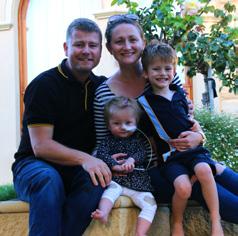
3 minute read
Calm after the storm
Florey researchers are developing new medicines to treat childhood epilepsy caused by genetic mutations. At the helm are Deputy Director and NHMRC fellow, Professor Steve Petrou, and his colleague Associate Professor Chris Reid.
Chris Reid has researched epilepsy for more than 15 years, a basic scientist driven by the urge to solve biological mysteries and garner fundamental knowledge to further medical science. It was a huge eyeopener for him to receive an appeal from, then to meet the parent of a baby girl who was having severe seizures.
“It’s rare for me to be in contact with patients. It was a real insight, working in my ivory tower doing my research on biological puzzles,” Chris says. “For families, having a child with epilepsy is devastating.”
Epilepsy, an electrical disorder of the brain causing debilitating seizures, affects 1-2 per cent of the population. It arises in many forms.
Ebony had her first seizure when she was three months old. Her mother Alli watched alarmed as her baby daughter frothed at the mouth, stiffened, convulsed and struggled to breathe before being airlifted to hospital. Ebony was hospitalised for 11 weeks after the second seizure, with Alli staying in a nearby ward, as husband Tim took leave to care for the couple’s four-year-old son. Ebony was wracked by up to 20 seizures a day as doctors desperately tried various medications. The medicos could only say that Ebony had a rare condition but that they didn’t know what it was. Ebony went home on four medications – all of which carried warnings about possible side-effects, including irreversible eye and liver damage.
Troubled by the amount and nature of the drugs being administered to his daughter and keen to find out if there were more specific, effective medications, Tim contacted a paediatric doctor he’d met on an overseas work trip who practised at a Munich children’s hospital.
He mentioned the de novo (‘of new’) mutation Ebony had been diagnosed with –HCN1 – and was told there was a scientist in Melbourne whose HCN1 research was known to German researchers.
Chris Reid was keen to help. His first task was to create a means to study the specific disorder, in this case a specially engineered mouse model of the HCN1 mutation.
“We are pretty excited about this!” says Alli.
“And very thankful he is taking it on.”
Says dad, Tim: “Our hope is that we can rationalise Ebony’s medications and find something that can help her better. We’d be happy if anything that could help her came out of the research.”
“And if it could help other people,” adds Alli.
The targeted approach may help with Ebony’s care, but beyond this may provide a broad-brush understanding of the mechanisms underlying
Ebony’s epilepsy, potentially extending to therapies for other sick kids.
Chris’ work into childhood epilepsy overlaps with that of fellow basic scientist and Institute Deputy Director, Professor Steve Petrou.
Steve is also investigating “de novo” mutations – new genetic mutations found in children but not in their parents, which can cause rare yet very severe epilepsies.
“There’s a massive clinical need for these children – they’re falling through the cracks,” Steve says. “No therapies work, creating a huge burden in society and for the carers. These children need round-the-clock care. It’s a massive medical problem, even though the mutations are rare.”
Steve is focussing on mutations in other excitability genes, one of which causes Dravet syndrome, in which seizures begin in the first year of life and are prolonged. “Some of these kids can live to 30 or even 40 but a lot will die of what’s called SUDEP, sudden unexpected death in epilepsy – it’s like the Sword of Damacles hanging over them and their parents,” he says.
“The upside is that we know precisely what the genetic mutations are and can study the mechanisms to understand the root cause of the disease, and deliver a therapy, rather than just treating the symptoms.”
Steve and colleagues have entered an exciting new phase; turning the fruits of their research into gene therapies. He has founded two companies in the US – one with early clinical trials on the way, and the other, preparing trials for a new type of customised gene therapy in a few years.
Gene therapy for Ebony’s epilepsy is one of Tim and Alli’s dreams.

Chris shares with us his favourite book “Origin” by Dan Brown For a light read on holiday—Dan Brown’s new book ‘Origin’ is an interesting take on the evolution of artificial intelligence.
Steve shares with us his favourite book
“The Immortal Life of Henrietta Lacks” by Rebecca Skloot
Many of us use HeLa cells in our research and this books speaks to the early struggle science had with ethics and social equality in a turbulent time in American history and the long term impact on a family. Engaging and conflicting.
Wah Chin Boon shares with us her favourite book “The Man Who Mistook His Wife for a Hat and Other Clinical Tales” by Oliver Sacks
A 1985 book by neurologist Oliver Sacks describing the case histories of some of his patients. The title of the book comes from the case study of a man with visual agnosia.








